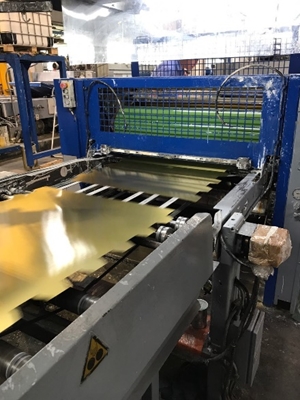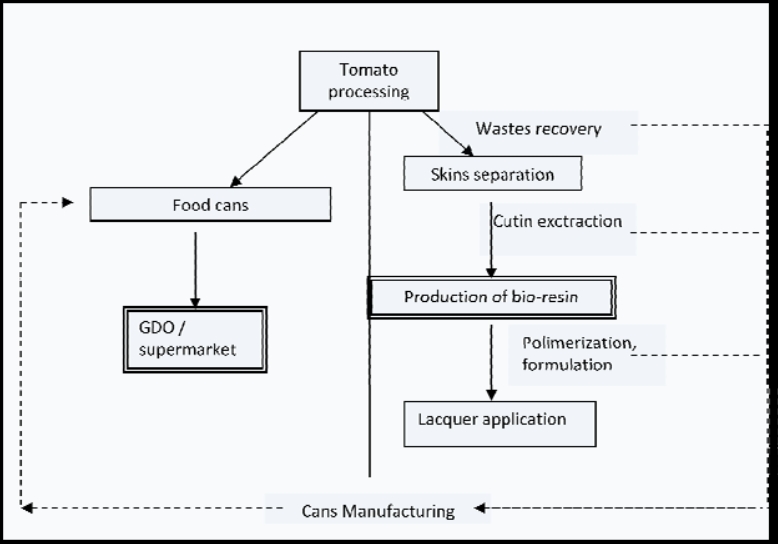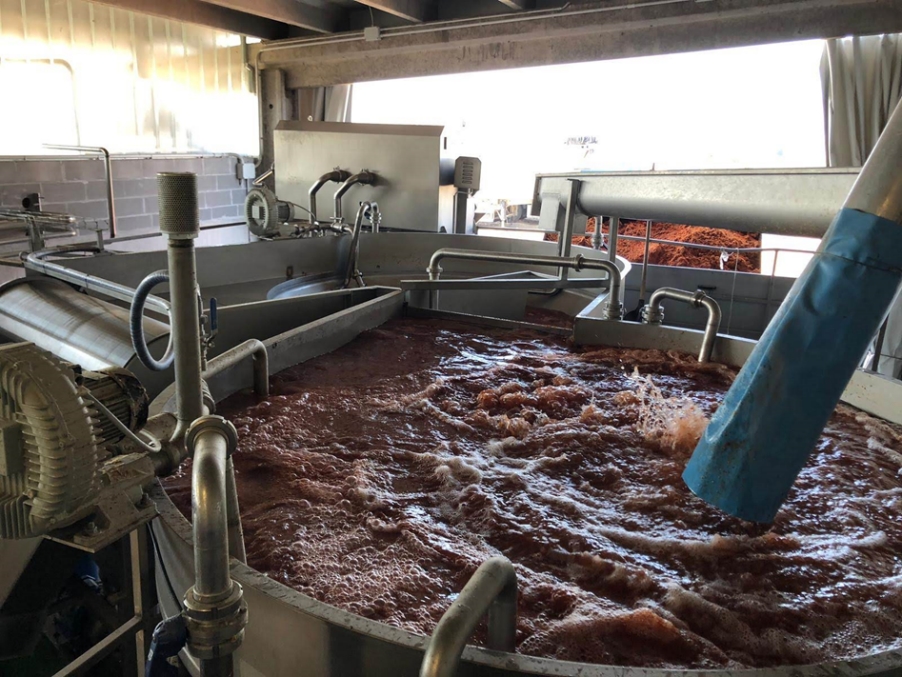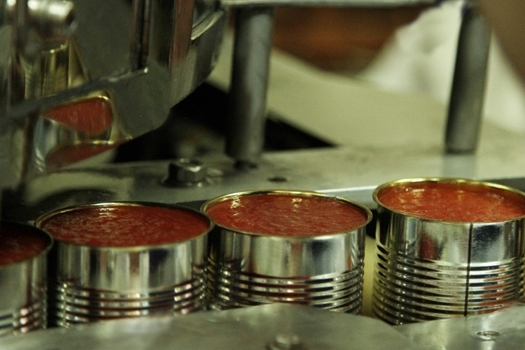Press release
, François-Xavier Branthôme
Angela Montanari: “…a double utilization of tomato waste is possible”
The start-up TomaPaint srl was founded at the beginning of March 2019 by cofounders Angela Montanari, Stefano Chiesa, Alessandro Chiesa and Tommaso Barbieri.
The core business of the project is the industrial production and distribution of a natural bio-resin obtained as a by-product of industrial tomato processing (mainly skins) (Fig.1). The construction of a production plant with a capacity of 500 kg/h is scheduled for 2020.
Fig. 1: A bio-lacquer from renewable resources
The bio-resin will be the main component of a bio-lacquer intended for application on the internal and external surfaces of metal cans for foodstuffs, in substitution of the traditional standard oil-based lacquers. The basic material is cutin, a component of the cuticle of tomato peel.
TomaPaint meets the requirements for sustainable production and for the safeguarding of consumer health. It complies with circular economy principles, enhancing the value of agro-industrial by-products and using renewable resources (Fig.2).
Fig. 2: A circular economy approach
The highly innovative eco-friendly packaging protects consumer health and limits the risk of contamination. It can compete with other packaging materials such as bioplastics. Another of its key advantages is that it increases the recyclability of metal packaging, a form of packaging that is currently perceived by consumers as being out of date.
TomaPaint is usable on standard production lines without any modification. This is a very important fact that makes the new product immediately applicable.
The new bioresin is extracted from the cuticle of tomato peel by means of an optimized, standardized and patented method (Fig.3). Moreover, the peels remaining after extraction demonstrate better performances in biogas production than peels that have not undergone this process.
TomaPaint is the outcome of a project started more than ten years ago and it is the launch-pad of a new adventure.
Fig. 3: Different steps of the process
The original idea of TomaPaint is based on an old patent developed in the 1940s by the Experimental Station for the Food Preservation Industry (SSICA), an Italian public research organization, and on work carried out in the context of several European projects: FP7 BIOCOPAC, LIFe BiocopacPlus and BBI-H2020 Agrimax.
Close collaboration with researchers has enabled the development of innovative technology for the extraction of a biopolymer and the development of a bio-lacquer, both in a laboratory and at a pilot scale.
Fig. 4: Tomato by-products
Fig. 5: Flotation step
The process consists in the separation of peels by flotation (Figs. 4 and 5), which are then heated in an alkaline solution, with the separation achieved by means of centrifugation of a liquid solution. In this way, the cutin is precipitated by acidification (Fig.6) before being separated by centrifugation.
Fig. 6: Cutin precipitation
Oligomerized cutin makes up the building-blocks of the new bio-resin. The main variables of the bio-resin production process have been studied and determined: time and temperature of the heat treatment, concentration of the alkaline solution, pH of precipitation. Moreover, several purification steps have also been evaluated.
Evaluations of the production capacity and of the regularity of the process have been carried out using specific laboratory tests for each phase. To minimize the environmental impact of the process, resources and energy consumption have been optimized, including through the recirculation of solutions and the reduction of temperatures and treatment times. Furthermore, both solid and liquid forms of waste generated by the process were used directly for the production of biogas, meaning that no waste was produced.
To standardize the extraction procedure, the bio-resin has been analyzed in relation to its unit and monomeric composition, using different analytical techniques: FTIR (Infrared Spectroscopy), GPC (Gel permeation Chromatography), GC-MS (Gas-Mass Spectroscopy).
The GPC analysis performed during the experimental work demonstrated that the extraction process results in a partial depolymerization of the natural bio-polymer with an average molecular weight of 650 g/mole. The GC-MS analysis showed that the degree of purity of cutin was very high, to the point that the concentration of 10.16 dihydroxydecanoic acid, the main component of tomato cutin, was 70-80%.
The process set-up at a pilot plant level was very efficient, with a very high average extraction yield of about 10-15%. The process developed is eco-friendly as it only uses aqueous solutions at different pH values (acidic and basic), and no organic solvents are used.
In this way, cutin is polymerized via homopolymerization to obtain the bio-resin, which is the main component (50-70%) of the new lacquer. Cutin causes no chemical or microbiological contamination, even though it comes from waste. Heavy metals are recorded at <10 ppb, and there is no pesticide residue or microbiological charge.
 Fig. 7: Bio-lacquer application on an industrial line
Fig. 7: Bio-lacquer application on an industrial line
The lacquer was then produced on an industrial line (50 kg) (Fig. 7) without changing processing times and temperatures. It has been applied to tinplate, tin-free steel and aluminium. The lacquer shows good chemical and mechanical properties, and good adherence and corrosion resistance. The results of all the tests it underwent were positive and comparable to those of standard lacquers. The overall and specific migration tests carried out on the cans in different simulations gave positive results well within the legal range.

Fig. 8: Three-piece cans
About 3 000 tin cans made up of 3 pieces and weighing 0.5 kg each and their tin free steel ends were produced on an industrial line (Fig. 8). The cans were filled with lentils and borlotti beans, tomato sauce and pulp (Fig. 9), and diced meat.
Fig. 9 Bio-lacquer cans filled with tomato products
A pack test was carried out at different storage temperatures for two years. The results are satisfactory and comparable to those of standard lacquers for all the products, thus highlighting the real and possible use of this lacquer for metal food-contact packaging.
Positive results were obtained in all phases of the experimental trials carried out.
By means of Life Cycle Assessment, the environmental impact of the new bio-lacquer protected cans was compared with oil-based lacquered containers. The results are relevant: in comparison with a standard lacquer of fossil origin, emissions of CO2 eq. are 730 mg lower for each can. A medium-sized lacquer manufacturer produces on average 30 000 tonnes/year. If in an initial phase of production, at least 4 000 tonnes/year of standard lacquer can be replaced with lacquer derived from tomato, this will enable a reduction of CO2 eq emissions of 2 tonnes/year. Considering that 650 000 tonnes of metal packaging are used in Italy every year, the emissions reduction could be impressive, i.e. some 1 million kg of CO2 eq/year.
In conclusion, the bio-resin has been produced industrially with optimal properties and validated with different food products. The compliance of the new can with national and European law has been verified through tests of global and specific migration in different simulations. A comprehensive and complete study comparing the carbon footprint of the new bio-resin with traditional resins has been performed by means of LCA.
After years of experimentation, the overall results have shown that the waste of the industrial processing of tomatoes is a valid raw material, which can represent a real ecological alternative for the coating of metal packaging, with satisfactory performances for different types of food.
The use of TomaPaint will have a positive impact on the whole agro-industrial supply chain, from farm to large retail operators, and including lacquer manufacturers and packaging producers.
In particular, the advantage for tomato growers and tomato processors consists in the value given to their processing waste and a consequent reduction in disposal costs. In Europe, this industrial sector involves more than 3 000 processing companies. In Italy, the disposal cost is around 4 Euro per tonne (for transport). Every year, the disposal cost of all Italian tomato waste amounts to more than EUR 600 000. So TomaPaint can enable big financial savings and enhance the use of tomato by-products. The study has shown that tomato waste can be stored during the tomato season, and then used throughout the year for cutin extraction. This is an undeniable advantage for the continuous operating of the plants. Moreover, the research has also demonstrated that the waste remaining after cutin extraction can still be used for the production of biogas with better performances. So a double utilization of tomato waste is possible. Thanks to TomaPaint, tomato processing companies can cut their costs and increase their benefits and gains. Moreover, the European tomato industry can also benefit from using a more ecological packaging, i.e. metallic cans protected with cutin based lacquers.
In addition, the new bio-lacquer is less influenced by geopolitical conditions than oil-based lacquers. The production of a natural BPA-free lacquer is an advantage for the whole agro-food chain, all the way to the end consumers, because it solves the problems of migration of dangerous synthesized substances into the food content.
Source & Contact: angela.montanari@tomapaint.com







































